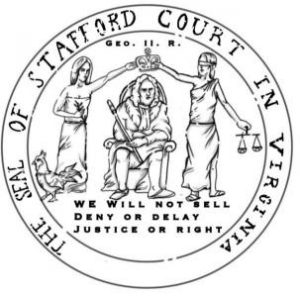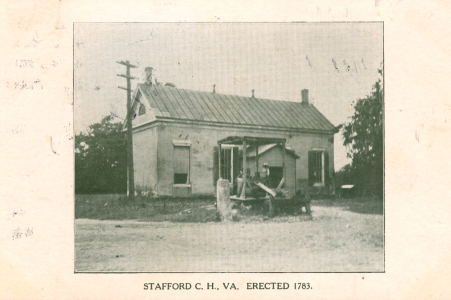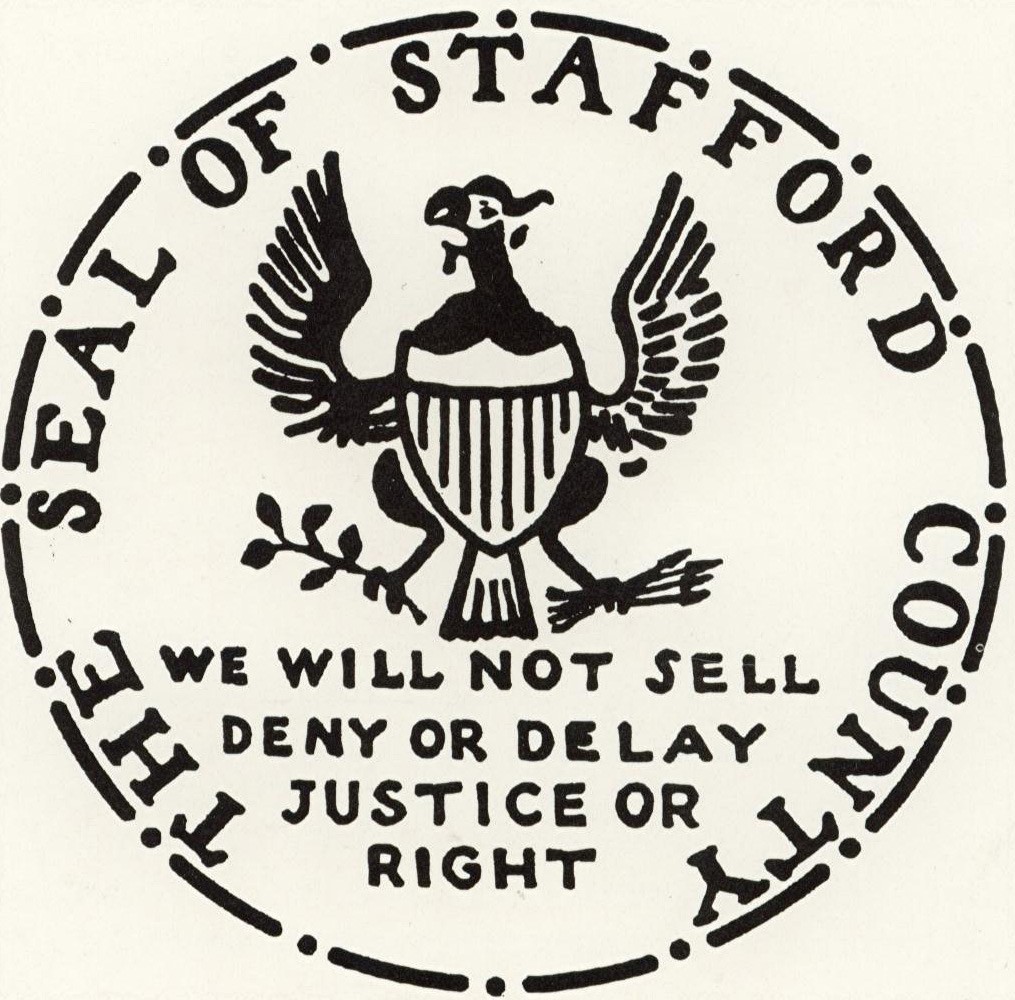Stafford Courthouse
From the earliest days of Virginia’s history, the Clerk of the Court was one of the most important county officers. His primary responsibility was to maintain the court records and the vital statistics for his county. Until the mid-nineteenth century, the clerks were also critical to the effective administration of their jurisdictions. While most county affairs were handled by a group of justices or magistrates that met once a month, many of these men had no legal training. At times, the clerk was the only person associated with the court who was versed in the law and his advice surely guided many of the court’s decisions. The early justices were, for the most part, planters. They lived in different parts of the county, and normally only appeared at court when on official duty. Unlike the court, which generally met only once a month, the clerk was on duty every day and could be consulted on a variety of legal problems when no magistrate was available. Once appointed, clerks tended to remain in office for the remainder of their lives and, in some instances, the position became informally hereditary. It was not uncommon for a son to succeed his father as clerk, as was the case in Stafford County with Henry Tyler (c.1710-1777) who was followed in office by his son, Thomas Gowry Strother Tyler (c.1740-1816).
An integral part of every clerk of court’s office was the county seal. This was used to imprint an identifiable image on official documents to help prevent counterfeiting and fraud. Stafford’s colonial-era seal, which would have been designed and made following the county’s creation in 1664, featured King George, II. Despite the seal’s use on what was likely a large number of official documents, the author has not yet seen a single document marked with it. A post-Civil War description of the seal reads:
The seal is round in shape, of iron, and is one and a half inches in diameter, four and three fourth inches in circumference, one and a half inches high and weighs about a pound. It represents the King sitting on his throne with two female figures on either side, representing “Justice” and “Right,” holding with one hand a crown over the king’s head, “Justice” holding in the other hand a pair of balances and “Right” a sprig of evergreen, with a fowl at her feet. Underneath them is this inscription, “We will not sell, deny, or delay justice or right.” Over the King’s head is the inscription, “Geo. II. R.,” and around the seal the words, “The Seal of Stafford Court in Virginia”…George II ascended the throne of England in 1728 and died in 1760. Hallam says his reign was the most prosperous period that England had ever known. This was the result not alone from the acquisition of new territory but also from the conquests of new fields of thought effected by Pope, Samuel Johnson, Fielding, Smollet, Reynolds, Hogarth and many others (Fredericksburg Star, July 1, 1891).

This is the seal that would have been used at the various courthouses on Potomac Creek and at Marlborough. The colonial seal would have ceased being used during or after the American Revolution. In response to independence, the seal depicting the English king was replaced by a Federal style seal. The Federal seal featured a stylized eagle holding in his claws on the right side a bundle of arrows and in his claws on the left an olive branch. The designers retained the wording, “We will not sell deny or delay justice or right.”
In the mid-nineteenth century, the prospect of war with the north loomed and the Stafford magistrates discussed how best to deal with the county’s records. Many Virginia counties opted to send their court records to Richmond, possibly believing that that city would be strongly defended against enemy attack. In March 1862 the justices decreed, “The [Stafford] Court having maturely considered the propriety of removing the records, books & papers of the County to some safer point (& having advised with the attorney for the Commonwealth & others) are of opinion that the said records &c. shall not be removed under any contingency from said office and further are of the opinion that the Clerk of this Court ought not to be considered in any wise responsible for said records &c. should he think proper to leave said County on the approach of the enemy” (Stafford Circuit Court Minutes, 1852-1867, p. 401). This stipulation was critical as without such an understanding the clerk could have been held responsible for the loss of records entrusted to his care.
Over the course of the Civil War, the Union army passed through Stafford several times. Their longest and most destructive period of occupation lasted for about fourteen months. During this time, they made at least two destructive raids on the courthouse and clerk’s office. The soldiers stole or destroyed about two-thirds of the county’s court records, including nearly every loose paper filed with the clerk prior to 1862. Had these books and papers been transferred to Richmond, they might all have been lost as the Confederates pulled out and left the city in flames. Thus, perhaps Stafford is fortunate to have the one-third of her antebellum records that do survive.
Lost also during this time was the county’s colonial-era seal. A newspaper article appearing many years after the war explained the theft and subsequent recovery of the seal:
Probate Clerk E. M. Young, of Silver City, New Mexico, who is on a visit to his father in this city, has in his possession a rare relic of Colonial days. It is the seal of Stafford County, Virginia, in the days of George II, and was taken from the old Court House in March, 1862 when Gen. Daniel E. Sickles, with 2,000 men, crossed over from Liverpool Point. It fell into the possession of Capt. Wm. H. Hugo, Company C, 70th New York volunteers, who was in the advance and took possession of the old Court House…At the same time the old English Bible belonging to the court was taken, and while the troops were crossing Aquia Creek it was dropped into the water and lost.
Probably Mr. Young will restore this ancient relic to the County Court of Stafford, where it will no doubt be zealously preserved and greatly appreciated (Fredericksburg Star, July 1, 1891).
It seems that Edgar Young did indeed return the seal to the Stafford Court. Nearly ten years later, a newspaper article again described the seal and noted that it had been returned to the clerk’s office. The article reads:
An Old Seal
The following is a description of an old colonial seal of Stafford county, in the Clerk’s office at Stafford C. H.” Inscription: “The seal of Stafford county, in Virginia.” George II Rex – We will neither sell, deny, nor delay, justice, or right.” Figures—Two females crowning a male seated in a chair. This seal was taken from the Clerk’s office in 1862 by a private soldier of the Excelsior Brigade, commanded by Gen. Daniel Sickles, who crossed the Potomac at Liverpool Point on the Potomac, and with his command made a raid as far south as Stafford C. H., Va. The Brigade stayed at the Court-house all night and thoroughly looted the Clerk’s office, taking away and destroying most of the records, some of which have been returned. The jail was burnt as well as the residence of Dr. V. Y. Conway. The seal was taken from the soldier by one of the captains of the Excelsior Brigade, who afterwards went to Silver City, New Mexico. Mr. Edgar M. Young, of Fredericksburg, Va., had gone to that point and had been elected as clerk of court. He got acquainted with this captain, who turned the seal over to him, and upon his return to the Burg on a visit brought it with him and turned it over to Hon. W. Seymour White, who was then Commonwealth’s Attorney of Stafford county, Va. It is now deposited in the Clerk’s office. (Free Lance, Nov. 16, 1901)
The author has seen no other reference to Stafford’s jail having been burned and that information may not be quite correct. From the wording of the article it seems as though the writer of the newspaper article had visited the clerk’s office and seen the seal himself. Despite the statement that the seal had been returned to the Stafford clerk’s office, it’s not been seen in decades and this is the last mention of the colonial seal known to the author. William Seymour White (1853-1897) served as Stafford’s Commonwealth’s Attorney from 1884 to 1895. What became of the seal after 1901 is a mystery.
Stafford’s Federal seal was also lost to the Union occupation. The court minutes read, “The Court now without a seal, the same having been lost or destroyed during the late war it is ordered that the Governor be requested to provide a seal for the Court to be deposited with the Clerk thereof according to the Code of 1860 Ch. 161 and that a copy of this order be forthwith sent by the Clerk to the Governor” (Stafford Court Minutes, 1852-1867, p. 466). This seal was also heavily used and eventually required replacing. The minutes of the County Court of Dec. 19, 1900 state that the seal “now in use in the Clerk’s office is worn out, having been used for about 34 years, it is ordered that the Clerk of the Court request the Governor to furnish a new County Court Seal for this County.” The Federal seal remained in use until 1964 when the celebration of the county’s three hundredth anniversary spurred the design of a new seal. This rather unimaginative effort depicts the present courthouse. The promise of “justice” and “right” was replaced by the words, “300 Years of Progress.”
Housed in the Stafford Clerk of Court’s office is one of the Federal-style seals. This may be the one procured around 1901 as old seals were likely destroyed upon arrival of the replacements in order to discourage fraud.


